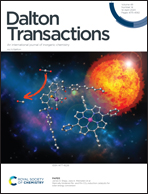Evidence of anomalous conventional and spontaneous exchange bias, high coercivity in Fe doped NiCr2O4 spinel†
Abstract
NiCr2−xFexO4 (x = 0 and 0.2) polycrystalline ceramics have been synthesized successfully through a simple co-precipitation technique to study the evolution of structural and magnetic properties by doping Fe. X-ray diffraction (XRD) reveals that the high-temperature cubic phase (space group Fd![[3 with combining macron]](https://www.rsc.org/images/entities/char_0033_0304.gif) m) observed at 320 K in bulk NiCr2O4 is stabilized at room temperature by decreasing the particle size to nanometer in x = 0 as well as after incorporating 20 at% Fe in the NiCr2O4 lattice. The cation distribution obtained from X-ray absorption fine structure (XAFS) analysis illustrates that while in x = 0, Ni2+ and Cr3+ ions occupy the tetrahedral (A) and octahedral (B) sites, respectively, x = 0.2, Fe3+ and Cr3+ ions occupy the A and B sites, respectively, and Ni2+ ions are distributed among the A and B sites. This transformation from the normal to mixed spinel structure strongly affects the magnetic properties. While the paramagnetic to long-range ferrimagnetic ordering temperature TC is enhanced from 71 to 192 K, significantly large coercive field (HC) of ∼29 kOe is observed for x = 0.2 as compared to the HC ∼13 kOe for x = 0. Moreover, unusually large conventional and spontaneous exchange bias fields of ∼26 and ∼2.6 kOe are observed for x = 0.2, which is absent for x = 0. The presence of anomalous exchange bias field is ascribed to the unidirectional exchange anisotropy between the two magnetic sublattices at A and B sites. The training effect of the exchange bias field is discussed using a phenomenological model, which considers the contribution from irreversible uncompensated spins that modify the exchange anisotropy at the interface between A and B magnetic sublattices. In addition, diffuse neutron scattering (DNS) with XYZ analysis is employed for both compositions to clearly illustrate the low-temperature peculiar magnetic phase transitions such as spin spiral transition, TS and spin lock-in transition, Tl. The DNS demonstrates that while Tl decreases from 10 K to 7 K with the incorporation of Fe in the NiCr2O4 lattice, TS significantly increases from 28 K to 50 K.
m) observed at 320 K in bulk NiCr2O4 is stabilized at room temperature by decreasing the particle size to nanometer in x = 0 as well as after incorporating 20 at% Fe in the NiCr2O4 lattice. The cation distribution obtained from X-ray absorption fine structure (XAFS) analysis illustrates that while in x = 0, Ni2+ and Cr3+ ions occupy the tetrahedral (A) and octahedral (B) sites, respectively, x = 0.2, Fe3+ and Cr3+ ions occupy the A and B sites, respectively, and Ni2+ ions are distributed among the A and B sites. This transformation from the normal to mixed spinel structure strongly affects the magnetic properties. While the paramagnetic to long-range ferrimagnetic ordering temperature TC is enhanced from 71 to 192 K, significantly large coercive field (HC) of ∼29 kOe is observed for x = 0.2 as compared to the HC ∼13 kOe for x = 0. Moreover, unusually large conventional and spontaneous exchange bias fields of ∼26 and ∼2.6 kOe are observed for x = 0.2, which is absent for x = 0. The presence of anomalous exchange bias field is ascribed to the unidirectional exchange anisotropy between the two magnetic sublattices at A and B sites. The training effect of the exchange bias field is discussed using a phenomenological model, which considers the contribution from irreversible uncompensated spins that modify the exchange anisotropy at the interface between A and B magnetic sublattices. In addition, diffuse neutron scattering (DNS) with XYZ analysis is employed for both compositions to clearly illustrate the low-temperature peculiar magnetic phase transitions such as spin spiral transition, TS and spin lock-in transition, Tl. The DNS demonstrates that while Tl decreases from 10 K to 7 K with the incorporation of Fe in the NiCr2O4 lattice, TS significantly increases from 28 K to 50 K.



 Please wait while we load your content...
Please wait while we load your content...